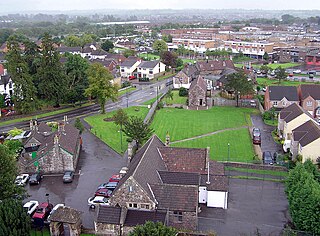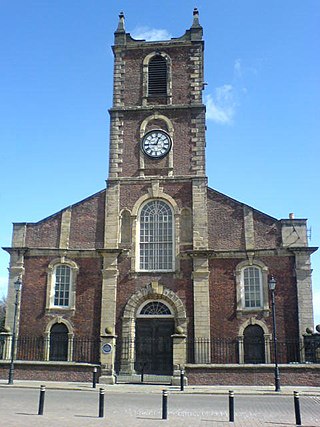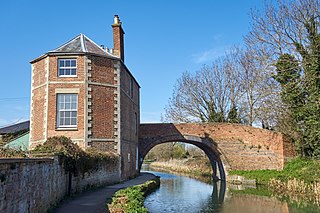
Thornbury is a market town and civil parish in the South Gloucestershire unitary authority area of England, about 12 mi (19 km) north of Bristol. It had a population of 12,063 at the 2011 census. The population has risen to 14,496 in the 2021 census. Thornbury is a Britain in Bloom award-winning town, with its own competition: Thornbury in Bloom. The earliest documentary evidence of a village at "Thornbyrig" dates from the end of the 9th century. The Domesday Book of 1086 noted a manor of "Turneberie" belonging to William the Conqueror’s consort, Matilda of Flanders, with 104 residents.

South Gloucestershire is a unitary authority area in the ceremonial county of Gloucestershire, South West England. Towns in the area include Yate, Chipping Sodbury, Kingswood, Thornbury, Filton, Patchway and Bradley Stoke. The southern part of its area falls within the Greater Bristol urban area surrounding the city of Bristol.

Thecodontosaurus is a genus of herbivorous basal sauropodomorph dinosaur that lived during the late Triassic period.
Agrosaurus is a potentially dubious genus of thecodontosaurid sauropodomorph probably originating from the Magnesian Conglomerate of England that was originally believed to be a Triassic prosauropod from Australia. Agrosaurus would thus be the oldest dinosaur from that country. However, this appears to have been an error, and the material actually appears to come from Thecodontosaurus or a Thecodontosaurus-like animal from Bristol, England. The type species is Agrosaurus macgillivrayi.

Michael James Benton is a British palaeontologist, and professor of vertebrate palaeontology in the School of Earth Sciences at the University of Bristol. His published work has mostly concentrated on the evolution of Triassic reptiles but he has also worked on extinction events and faunal changes in the fossil record.

Tytherington Rocks F.C. is a football club based in Tytherington, near Thornbury, Gloucestershire, England. The club competes in the Hellenic League Division One and is affiliated to the Gloucestershire County FA.

The Burpee Museum of Natural History is located along the Rock River in downtown Rockford, Illinois, United States, at 737 North Main Street.

The Kimmeridge Clay is a sedimentary deposit of fossiliferous marine clay which is of Late Jurassic to lowermost Cretaceous age and occurs in southern and eastern England and in the North Sea. This rock formation is the major source rock for North Sea oil. The fossil fauna of the Kimmeridge Clay includes turtles, crocodiles, sauropods, plesiosaurs, pliosaurs and ichthyosaurs, as well as a number of invertebrate species.

The Churches Conservation Trust is a registered charity whose purpose is to protect historic churches at risk in England. The charity cares for over 350 churches of architectural, cultural and historic significance, which have been transferred into its care by the Church of England.

Terrestrisuchus is an extinct genus of very small early crocodylomorph that was about 76 centimetres (30 in) long. Fossils have been found in Wales and Southern England and date from near the very end of the Late Triassic during the Rhaetian, and it is known by type and only known species T. gracilis. Terrestrisuchus was a long-legged, active predator that lived entirely on land, unlike modern crocodilians. It inhabited a chain of tropical, low-lying islands that made up southern Britain, along with similarly small-sized dinosaurs and abundant rhynchocephalians. Numerous fossils of Terrestrisuchus are known from fissures in limestone karst which made up the islands it lived on, which formed caverns and sinkholes that preserved the remains of Terrestrisuchus and other island-living reptiles.

The Lapworth Museum of Geology is a geological museum run by the University of Birmingham and located on the university's campus in Edgbaston, south Birmingham, England. The museum is named after the geologist Charles Lapworth, its origins dating back to 1880. It reopened in 2016 following a £2.7 million redevelopment project that created new galleries and displays, as well as modern visitor and educational facilities.

The Stroudwater Navigation is a canal in Gloucestershire, England which linked Stroud to the River Severn. It was authorised in 1776, although part had already been built, as the proprietors believed that an Act of Parliament obtained in 1730 gave them the necessary powers. Opened in 1779, it was a commercial success, its main cargo being coal. It was 8 miles (13 km) in length and had a rise of 102 ft 5 in (31.22 m) through 12 locks. Following the opening of the Thames and Severn Canal in 1789, it formed part of a through route from Bristol to London, although much of its trade vanished when the Kennet and Avon Canal provided a more direct route in 1810. Despite competition from the railways, the canal continued to pay dividends to shareholders until 1922, and was not finally abandoned until 1954.

Thecodontosauridae is a family of basal sauropodomorph dinosaurs that are part of the Bagualosauria, known from fossil remains found exclusively in the Magnesian Conglomerate of Bristol, England, which dates back to the Rhaetian stage of the Late Triassic. Two genera are known: Agrosaurus and Thecodontosaurus; the former is often considered to be the same animal as the latter.

The Magnesian Conglomerate is a geological formation in Clifton, Bristol in England, Gloucestershire and southern Wales, present in Tytherington, Durdham Down, Slickstones Quarry and Cromhall Quarry.

Dinosaur Ridge is a segment of the Dakota Hogback in the Morrison Fossil Area National Natural Landmark located in Jefferson County, Colorado, near the town of Morrison and just west of Denver.

The Whitby Mudstone is a Toarcian geological formation in Yorkshire and Worcestershire, England. The formation, part of the Lias Group, is present in the Cleveland and Worcester Basins and the East Midlands Shelf.

Off The Record Bristol (OTR) is a mental health support and information service in Bristol which provides counselling, group workshops, anti-stigma campaigns, creative therapies, LGBTQ+ networks and support, stress management workshops and community-based support groups for young people. OTR works across Bristol and South Gloucestershire and is free at every point of access.

Robert Joseph Gay Savage was a British palaeontologist known as Britain's leading expert on fossil mammals. He worked at the University of Bristol for nearly 40 years and studied fossils around the world, especially in North and East Africa. He produced the 1986 popular science book Mammal Evolution: An Illustrated Guide and co-edited several technical books in the Fossil Vertebrates of Africa series with fellow palaeontologist Louis Leakey.
The Avon Fissure Fill, also known as the Bristol Fissure Fill or Tytherington Fissure Fill, is a fissure fill in Avon, England which dates variously from the Norian and Rhaetian stages of the Late Triassic, or possibly as late as the Hettangian stage of the Early Jurassic. The fissure fill at Avon was a sinkhole formed by the dissolution of Lower Carboniferous limestones.

Henry Riley (1797–1848) was a British surgeon, anatomist, naturalist, geologist and paleontologist. He is notable for being the co-discoverer and co-describer of the archosaur Palaeosaurus and the dinosaur Thecodontosaurus.
















